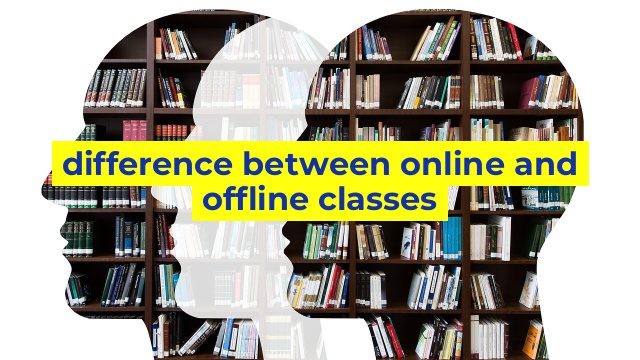The Difference Between Online and Offline Classes
Introduction:
The COVID-19 pandemic has forced many educational institutions to shift from traditional offline classes to online learning. Although both types of classes share similar objectives, there are notable differences between the two.
Flexibility:
Online classes offer flexibility that can be tailored to fit individual schedules. Learners can take courses at their own pace and during their preferred time. Offline classes, on the other hand, have fixed schedules with no room for adjustments, which can be inconvenient for some students.
Interaction:
Offline classes provide the opportunity for face-to-face interaction between instructors and students. This personal touch helps to establish a rapport and establish a comfortable learning environment for learners. Online classes lack this immediate personal interaction, which can cause a disconnect between instructors and students.
Access to Resources:
Online courses provide students with access to a vast range of reading materials, online resources, and forums. There is no physical library, but there are soft copies of all the books, downloads, podcasts, and multimedia that one may need. Although offline classes have libraries with a collection of books and other reading materials, these may be limited to the available resources provided within the institution.
Cost:
Online classes may be cheaper than offline classes due to reduced infrastructure and operational costs. Additionally, learners can save on transportation, accommodation, and other costs associated with attending an offline class.
Technological Requirements:
Online classes require a stable internet connection, access to a computer or mobile device, and basic knowledge of digital technology. Offline classes require attendance in a physical institution and may not have such technical requirements.
Conclusion:
Both online and offline classes have their strengths and weaknesses. The choice of which type of course to take depends on different factors such as time, cost, access to resources, interaction with others, and technological requirements. As we continue to face the challenges of the pandemic, online classes may be a more convenient option, but offline courses still have a place in education.
Table difference between online and offline classes
| Factor | Online Classes | Offline Classes |
|---|---|---|
| Mode of Instruction | Conducted via digital platforms such as video conferencing, webinars, or pre-recorded lessons. | Conducted in physical classrooms with face-to-face interaction between teachers and students. |
| Flexibility | Students can access classes from anywhere with an internet connection, and can attend at their own pace and schedule. | Students are required to attend classes at a fixed schedule, and need to be physically present in the classroom. |
| Interaction with Peers | Limited opportunities for social interaction, but can participate in online discussion forums or collaborate on group projects. | More opportunities for social interaction with peers, and can collaborate with classmates for group projects in person. |
| Teacher Availability | Teachers are mostly available via email or chat, and may take longer to respond due to their workload. | Teachers are available for immediate feedback and can provide one-on-one assistance or consultation. |
| Technology Requirements | Requires a computer or mobile device with internet connection and software for the specific online classes. | Requires physical presence in a classroom and access to educational materials such as textbooks or printed course materials. |


